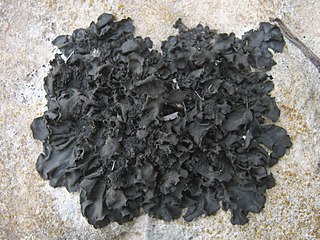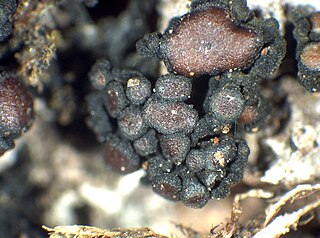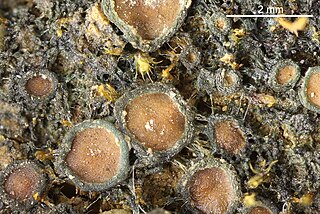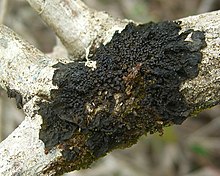
Collema is a genus of lichens in the family Collemataceae. The photobiont is the cyanobacterium genus Nostoc. Species in this genus typically grow on nutrient-rich bark or somewhat siliceous or calcareous rocks in humid environments.

The Arthoniaceae are a family of lichenized, lichenicolous and saprobic fungi in the order Arthoniales. The Arthoniaceae is the largest family of Arthoniales, with around 800 species. Most species in Arthoniaceae belong in Arthonia which is the largest genus with 500 species. The second and third largest genus is Arthothelium with 80 species, and Cryptothecia with 60 species.

Leptogium is a genus of lichen-forming fungi in the family Collemataceae. It has about 110 species. Species formerly classified under Leptogium have since been divided among the genera Leptogium, Pseudoleptogium, and Scytinium. Leptogium lichens are predominantly found on tree bark or soil, often among mosses, and sometimes on rocks in moist environments.

Lichen morphology describes the external appearance and structures of a lichen. These can vary considerably from species to species. Lichen growth forms are used to group lichens by "vegetative" thallus types, and forms of "non-vegetative" reproductive parts. Some lichen thalli have the aspect of leaves ; others cover the substrate like a crust, others such as the genus Ramalina adopt shrubby forms, and there are gelatinous lichens such as the genus Collema.

Opegraphaceae is a family of lichen-forming and lichenicolous fungi in the order Arthoniales. It was originally proposed by German lichenologist Ernst Stizenberger in 1862. It fell into disuse, but was resurrected in a molecular phylogenetic study of the order Arthoniales published in 2010. It now includes taxa that were previously referred to the family Roccellaceae, its sister group.

Blennothallia is a genus of jelly lichens in the family Collemataceae. It has four species, which collectively have a cosmopolitan distribution.

Scytinium is a genus of lichen-forming fungi in the family Collemataceae. It has 49 species. These lichens are typically found on basic rocks, soil, and trees, occasionally in association with mosses. Despite the morphological and ecological diversity within Scytinium, its species share similar ascospore features, such as shape and septation, as well as a small to medium-sized thallus with at least a partial cortex.

Lathagrium is a genus of lichen-forming fungi in the family Collemataceae. It has 10 species of gelatinous lichens. Species in this genus typically grow on calcareous rocks, often amidst mosses, but can also be found on siliceous or serpentine rocks, mortar, or soil.

Massalongiaceae is a small family of lichen-forming fungi in the order Peltigerales. It has three genera and seven species.
Koerberiaceae is a small family of lichen-forming fungi in the order Peltigerales. It contains 3 genera and 9 species. The family was proposed by Toby Spribille and Lucia Muggia in 2012, after molecular phylogenetic analysis revealed the existence of three lineages of lichen-forming fungi in the suborder Peltigerineae of the order Peltigerales. The lineages represented the genera Steinera, Koerberia, and Vestergrenopsis. The latter genus was later folded into synonymy with Tingiopsidium.

Rostania is a genus of lichen-forming fungi in the family Collemataceae. These lichens are primarily found on tree bark, occasionally on wood, with one species known to inhabit soil. The genus is characterized morphologically by having minute thalli made of hyphal tissue without a separate cortex, and the more or less cuboid-shaped ascospores.

The Collematineae are an suborder of rust fungi in the order of Peltigerales in the class Lecanoromycetes.

Hondaria is a single-species fungal genus in the family Collemataceae. It contains the species Hondaria leptospora, a corticolous (bark-dwelling), foliose lichen. This lichen was previously classified under the genus Collema, and later Arctomia, but molecular research combined with morphological analysis indicates that it forms a distinct genus. Named in honour of Dr. Neli Kika Honda, a researcher of lichen chemistry, Hondaria leptospora is notable for its long, thin, transversely-septate ascospores, the longest within its family. The species is found predominantly in the west-central regions of Brazil near the borders with Bolivia and Paraguay.

Enchylium conglomeratum, commonly known as dotted jelly lichen, is a species of foliose lichen in the family Collemataceae. Formerly known as Collema conglomeratum, it was renamed in 2013. This lichen has a fragmented distribution across the Holarctic region, occurring in both North America and Europe.

Enchylium polycarpon, commonly known as the shaly jelly lichen, is a species of foliose lichen in the family Collemataceae. Formerly known as Collema polycarpon, it was renamed in 2013 as part of a taxonomic revision. This lichen has a widespread global distribution, occurring in various regions of North America, Europe, Africa, and Asia.

Enchylium limosum, commonly known as lime-loving tarpaper lichen, is a species of crustose to subfoliose lichen in the family Collemataceae. This unique lichen species possesses a gelatinous thallus with a dark coloration, contributing to its distinctive appearance. It thrives in a diverse array of habitats spanning temperate to boreal-montane regions, across Europe, North America, Africa, and Asia.
Leptogidium is a genus of lichen-forming fungi in the family Pannariaceae. It has six species.

Callome is a fungal genus in the family Collemataceae. It consists of the single species Callome multipartita, a saxicolous (rock-dwelling), crustose lichen found in Northern Africa, Europe, and North America.
Nebularia is a small genus of lichen-forming fungi in the family Pannariaceae. It comprises two species, both of which are found in the Andes.
Pseudoleptogium is a fungal genus in the family Collemataceae. It comprises the single species Pseudoleptogium diffractum, a saxicolous (rock-dwelling) crustose lichen that grows on calcareous rocks.
















